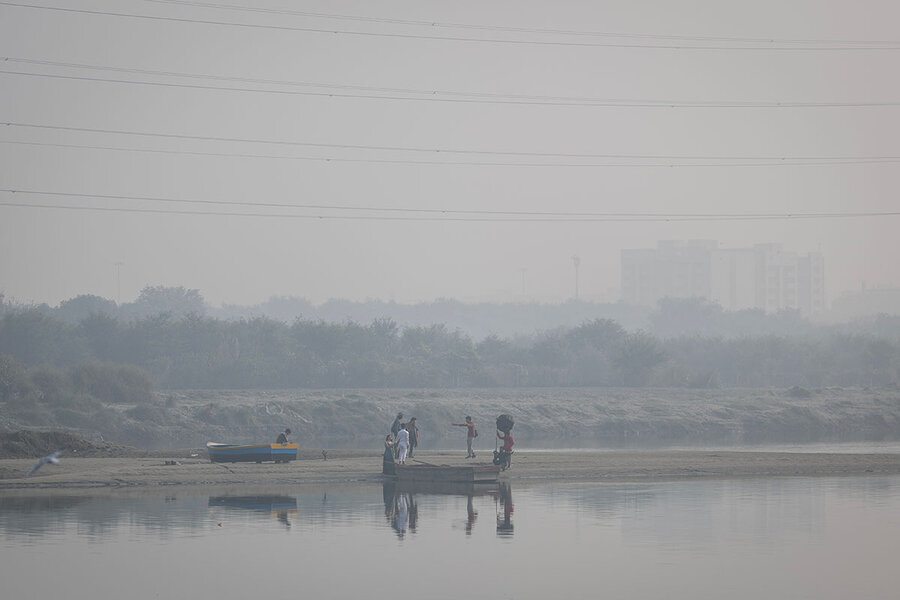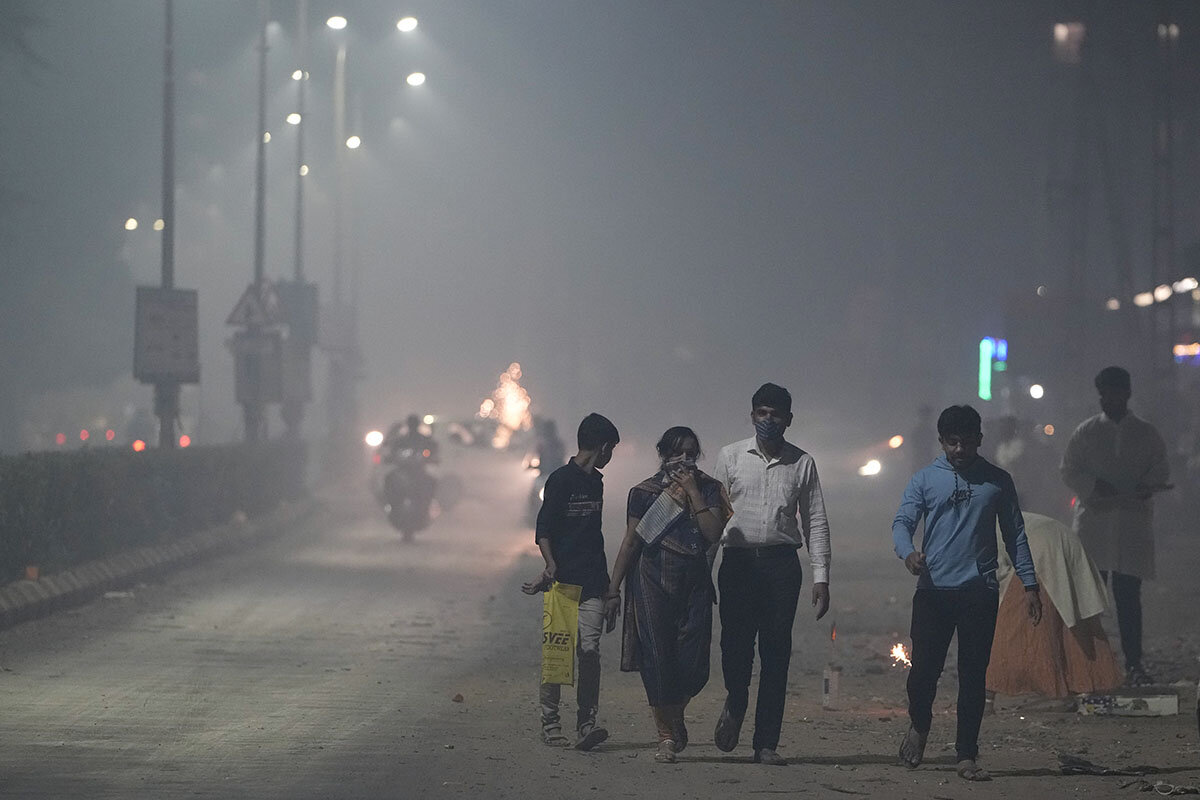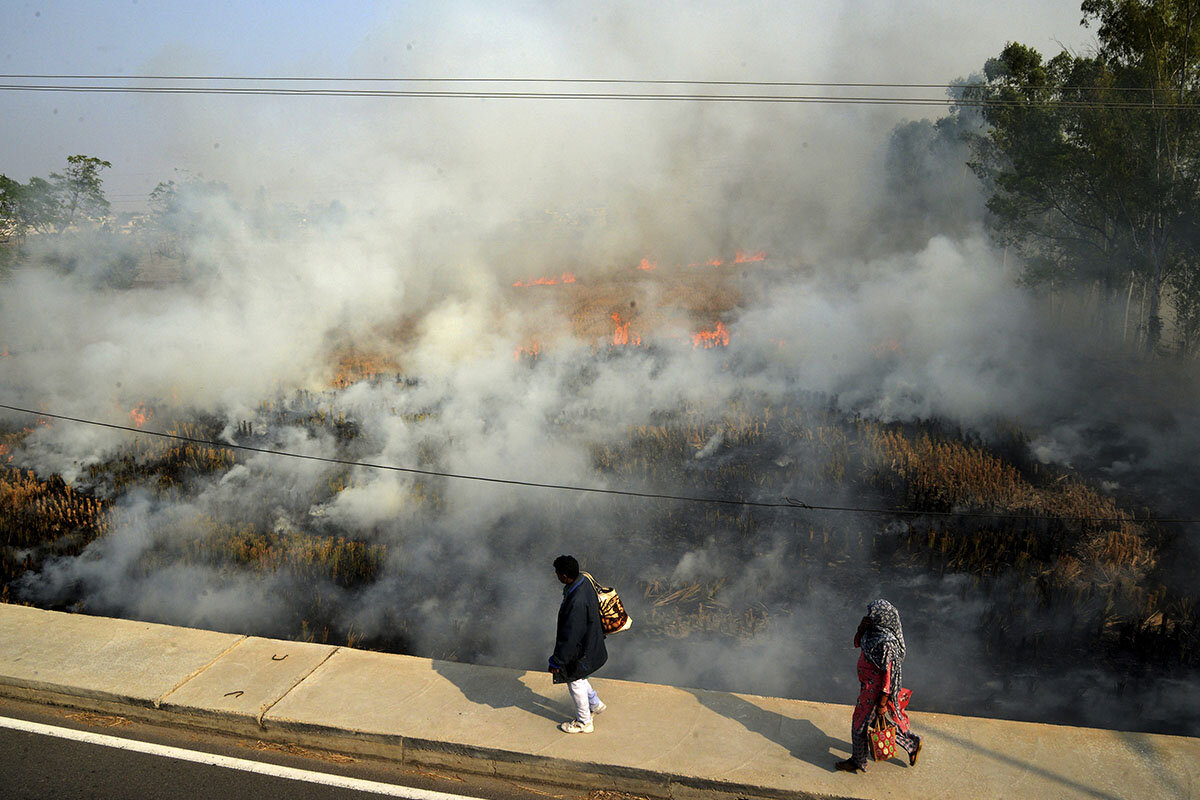Delhi dispatch: Through haze of smog and blame, signs of cooperation
Loading...
| New Delhi
When a hazy gray blanket of the year’s worst air pollution settled over the Indian capital last week, trucks carrying nonessential goods were banned until further notice. Primary schools were ordered closed, the idea being not just to keep smog-belching school buses idle but also to keep vulnerable schoolkids indoors.
On Sunday pollution conditions improved enough to rescind the toughest of the measures. The roller coaster of government actions has Delhiites seeking not just stopgap measures when air quality deteriorates, but solutions. One barrier is annual finger-pointing between city officials, who oversee local industry and traffic activity, and authorities in neighboring states, where farmers have long contributed to pollution by burning fields.
Why We Wrote This
A story focused onThe Monitor’s correspondent lands in Delhi just as a wave of severe air pollution envelopes the city. In conversations with Delhiites as well as from his air-purified hotel room, he observes an annual blame game unfold – and an earnest search for solutions.
Yet some residents are taking notice of what appears to be a new cooperative approach among regional leaders.
At a press conference Friday, Punjab Chief Minister Bhagwant Mann promised to devise a solution to the field burning problem by November 2023, and in a comforting show of regional cooperation, Delhi Chief Minister Arvind Kejriwal said that no one wins by blaming farmers for the Delhi region’s toxic air.
Instead, officials would come together to find equitable answers to a challenge affecting everyone. “The farmers need a solution,” he said.
When a hazy gray blanket of the year’s worst air pollution settled over the Indian capital last week, government measures to try to reduce the fog’s toxic levels were largely taken in stride.
With air quality stuck at a rating of “severe-plus” under the city’s Graded Response Action Plan, trucks carrying nonessential goods were banned until further notice. Most other diesel vehicles were also prohibited. Construction projects have been halted.
Primary schools were ordered closed, with classes shifting to online – the idea being not just to keep smog-belching school buses idle but also to keep vulnerable schoolkids indoors.
Why We Wrote This
A story focused onThe Monitor’s correspondent lands in Delhi just as a wave of severe air pollution envelopes the city. In conversations with Delhiites as well as from his air-purified hotel room, he observes an annual blame game unfold – and an earnest search for solutions.
Then on Sunday, pollution conditions improved slightly to “very poor” on the city’s air quality scale. That was enough to prompt Delhi’s Pollution Control Board to rescind the toughest of the measures ordered Friday. Primary schools are set to reopen Wednesday, despite a return this morning of the dark gray haze that first blanketed the city last week.
The roller coaster of government actions and reversals has Delhiites from schoolchildren’s parents to office workers and business owners seeking not just stopgap measures when air quality deteriorates, but solutions.
With the toxic stew becoming as regular a feature of Delhi’s fall months as leaf-turning is to New England, residents are calling for less reaction and more problem-solving. And to the relief of many, this year officials are showing signs of doing less finger-pointing and more cooperating on finding viable remedies to the recurring harmful haze.
Getting to the source
When it comes to the toughest of the air quality measures, such as the blanket truck ban, one sector of the economy is pushing back: India’s powerful wedding industry. Calling the trucks provisioning Delhi’s vaunted wedding markets “nonessential” is apparently fightin’ words.
With the fall months the kickoff of the country’s high wedding season, industry advocates are sounding the alarm: The truck ban will soon mean bare shelves in Delhi’s wedding markets, they say, which in turn will discourage Delhi’s brides-to-be, their entourages, and other wedding-goers from even visiting the markets.
“The impact is already visible. Many people are avoiding visits to the markets” even though the wedding season is in full swing, said Brijesh Goyal, chairman of Delhi’s Chamber of Trade and Industry, in a letter to Indian Prime Minister Narendra Modi.
The number of daily visitors to the wedding markets is down more than two-thirds, Mr. Goyal said.
The chamber is demanding Mr. Modi call an emergency meeting of the governments of Delhi and the adjacent states of Haryana, Punjab, and Uttar Pradesh to come up with a long-term response to the air quality crisis.
Calls for a regional approach to urban air pollution that is considered the worst – and deadliest – in the world hint at one of the major contributors to the soup Delhi bathes in: the annual burning of field “stubble” after crops are harvested.
Farmers in the states around Delhi set tens of thousands of fires beginning in late October to prepare fields for the next crop. The burning might make good agricultural sense, but every year the resulting smoke ends up in the atmosphere over Delhi’s 32 million people, where it mixes with the exhaust fumes and various particulates spewed by the city’s 13 million registered trucks, cars, and auto-rickshaws.
Not to mention what heavy industry mostly on the city’s fringes throws into the mix.
Studies show that while about half of Delhi’s air pollution comes from vehicles, another nearly 40% is the result of the field burning.
The city’s Hindustan Times carried a lead-story graphic Sunday that showed air quality improving slightly from Friday – but also indicating a substantial overnight rise in the number of farm field fires captured by satellite Saturday in Punjab and Haryana states.
Moreover, the newspaper reported that officials expect air quality indexes to deteriorate again this month as temperatures fall and field burns continue.
Seeking solutions amid the blame
The choking, visibility-hampering atmospheric conditions set off what has become an annual blame game pitting city officials against their neighboring-state counterparts.
“It’s your farmers!” one side harangues, while the other side counters, “No, actually it’s your cars and trucks!”
To which suffering residents respond, “Stop, you’re both right. But what we need are solutions.”
The states have tried to end the burning. Two years ago Punjab tried prohibiting the practice – only to have a court order the state to pay farmers not to burn fields.
As a result many farmers refrained from setting stubble fires. But when the compensation never materialized – the state said it simply couldn’t afford it – the burning resumed.
Another idea is to offer special machinery to gather the stubble and bury it, but so far that project has had limited success.
What has some residents taking notice is what appeared to be a new cooperative approach among regional leaders to solving the annual pollution crisis.
At a press conference Friday, Punjab Chief Minister Bhagwant Mann promised to devise a solution to the burning problem by November 2023.
And in a comforting show of regional cooperation, Delhi Chief Minister Arvind Kejriwal said as he stood next to his Punjabi counterpart that no one wins by blaming farmers for the Delhi region’s toxic air.
Saying this was no time for “a blame game,” Minister Kejriwal said officials would come together to find equitable answers to a challenge affecting everyone. Then he added, “The farmers need a solution; they will stop burning parali [stubble] the day they have a solution.”










